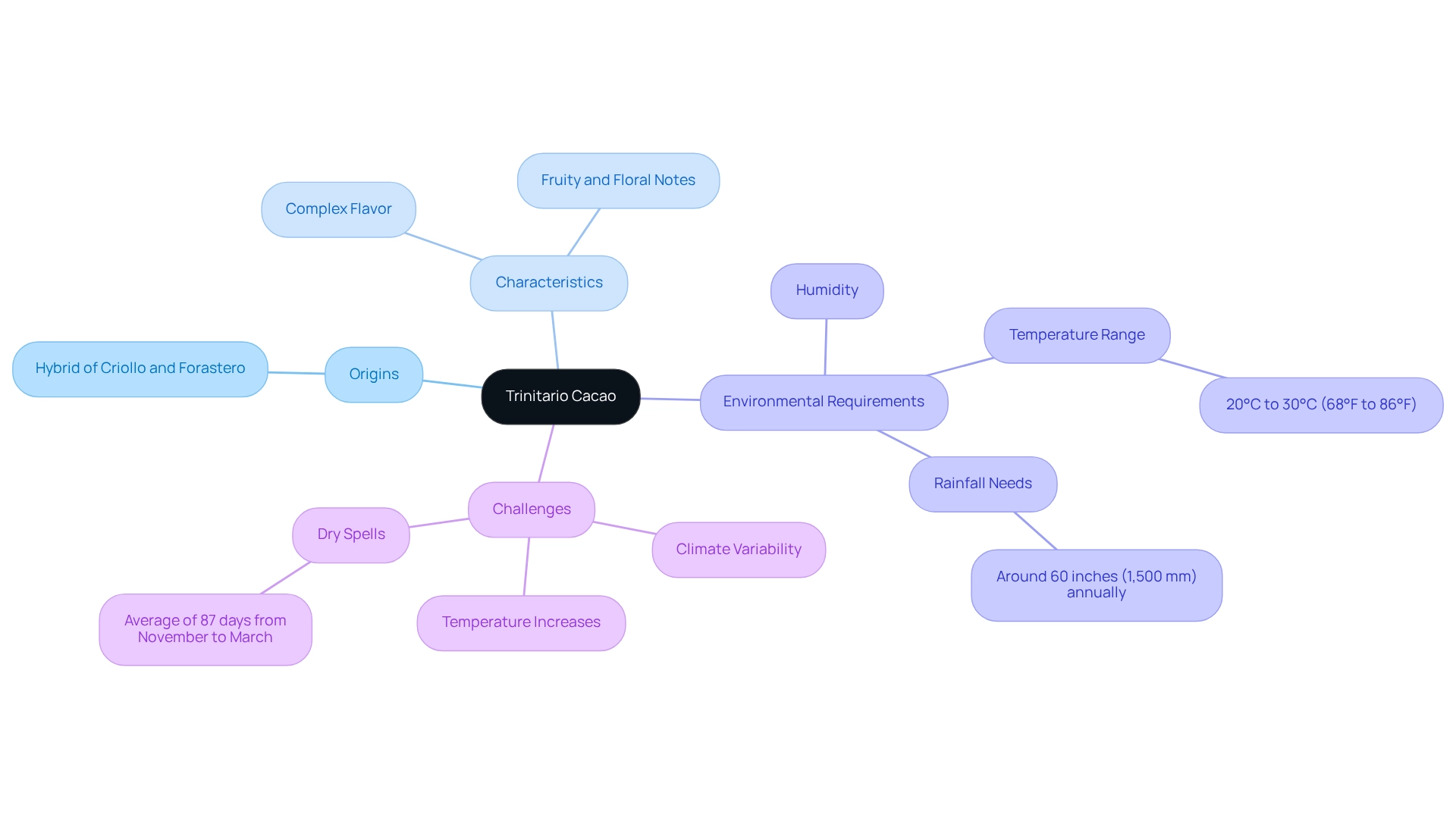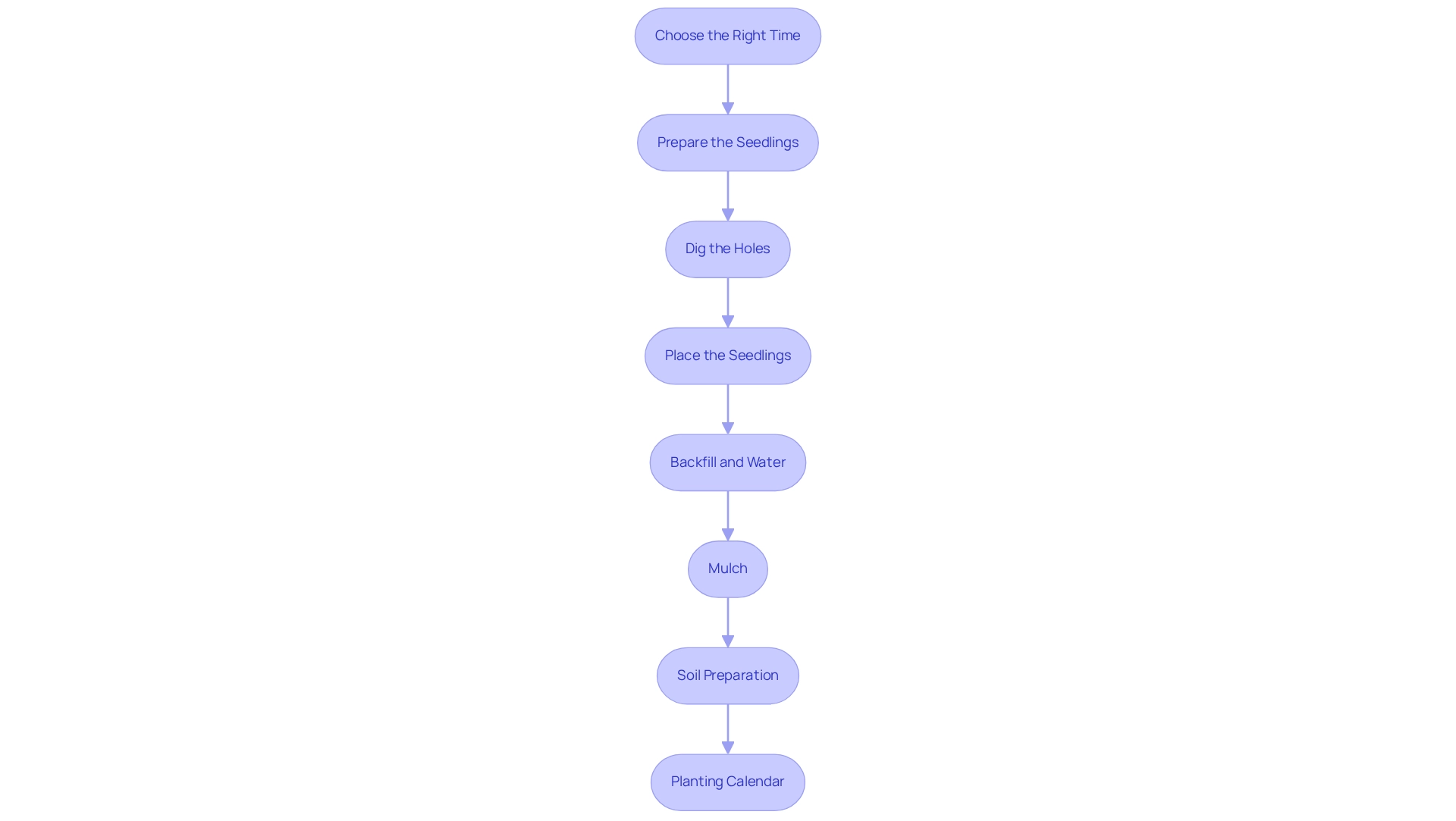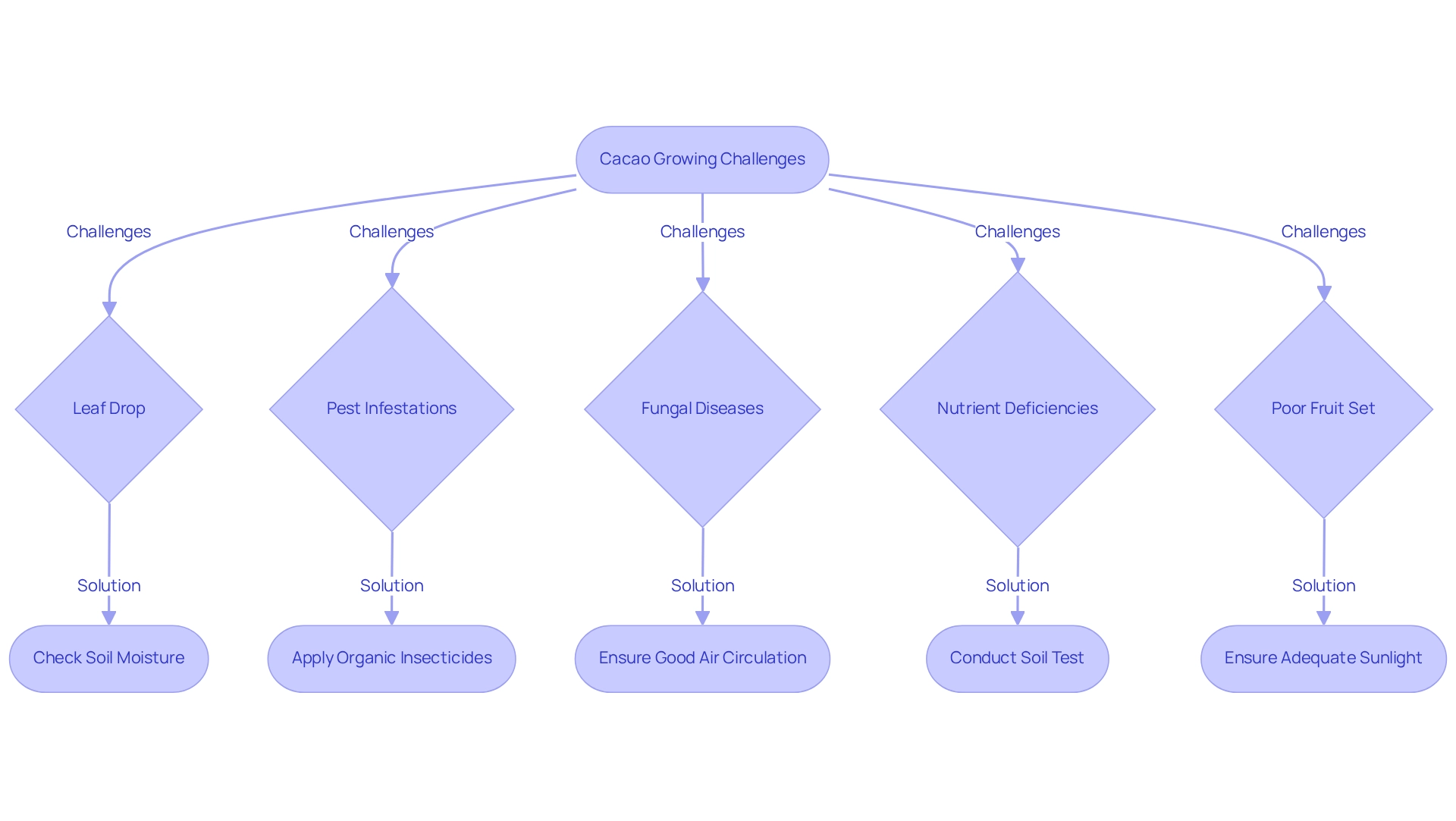Cultivating Trinitario cacao is a rewarding journey that requires specific environmental conditions and thoughtful management practices. We understand that every gardener faces unique challenges, and this unique cacao variety is no exception. To support your efforts, it’s essential to:
- Select the right planting time
- Maintain soil moisture
- Manage pests and diseases effectively
These steps not only enhance the success of your cacao plants but also lead to high-quality yields that you can be proud of.
Imagine the joy of nurturing your cacao plants, knowing that your careful attention will yield delicious results. As you embark on this journey, remember that each step you take is a part of a larger process of growth and connection to nature. By focusing on these essential practices, you can cultivate a thriving environment for your cacao, ensuring that it flourishes under your care.
So, let’s embrace this opportunity together! With patience and dedication, you can create the perfect conditions for your Trinitario cacao to thrive. Remember, we’re all in this together, and every effort you make brings you closer to a bountiful harvest.
Introduction
In the world of chocolate, the journey from bean to bar begins with the cacao tree. Among its many varieties, Trinitario stands out for its unique heritage and flavor profile. This hybrid cacao, born from the fusion of Criollo and Forastero strains in Trinidad, not only offers a complex taste experience but also presents specific cultivation challenges.
With climate change impacting cacao production across the globe, understanding the environmental needs and best practices for growing Trinitario cacao has never been more crucial. Have you ever faced challenges in your gardening journey? From selecting the right location and tools to managing care and addressing common issues, this guide delves into the essential steps for cultivating this prized cacao variety.
Together, we can ensure that growers thrive amidst the shifting landscape of agriculture. Let's explore these nurturing practices, so you feel empowered and supported in your cacao-growing endeavors.
Understand Trinitario Cacao: Origins and Characteristics
This variety of cacao, known as trinitario cacao, is a hybrid type that originated in Trinidad, emerging from a cross between Criollo and Forastero cacao plants. This unique lineage contributes to Trinitario's distinct flavor profile, often described as complex, with delightful fruity and floral notes. It flourishes in humid, tropical climates, requiring consistent temperatures between 20°C and 30°C (68°F to 86°F) and ample rainfall, ideally around 60 inches (1,500 mm) annually. Understanding these characteristics is essential for successful cultivation, as they dictate the environmental conditions necessary for optimal growth and yield.
Research shows that cocoa trees traditionally thrive under shade, especially during their early years, which helps protect them from harsh sunlight and promotes healthy development. Have you ever considered how climate variability affects chocolate production? Recent studies highlight significant challenges in regions like Côte d’Ivoire, where increasing temperatures and shifting precipitation patterns are becoming more pronounced. It’s crucial to adopt adaptation measures to alleviate these climate impacts, ensuring the sustainability of chocolate farming. As Antoine Alban Kacou M'bo from the African Center of Excellence on Climate Change wisely states, "It is necessary to take adaptation measures to mitigate climate impacts."
Successful examples of premium chocolate farming illustrate the importance of choosing cultivation methods that align with these ecological requirements. By focusing on the distinct characteristics of trinitario cacao and implementing optimal practices, cultivators can enhance their chances of producing high-quality products that meet market demands. Additionally, it’s important to note that the average duration for dry spells from November to March is 87 days, which can significantly affect cocoa farming. The
overall trend suggests warming over the next few decades, further complicating the challenges faced by chocolate producers. Together, we can navigate these challenges and work towards a sustainable future for chocolate farming.

Gather Tools and Prepare Your Garden for Planting
Before we embark on the rewarding journey of planting trinitario cacao, let’s gather some essential tools:
- A spade
- A hoe
- A watering can or hose
- Mulch
- Organic fertilizer
It’s crucial to select a location that receives partial shade and is shielded from strong winds. As Guy Sela, an experienced ag entrepreneur, wisely advises, ensure your chosen site is free of rocks and debris to prevent any damage during planting.
Now, let’s consider the
best practices for planting soursop trees. Choose a spot that allows for good air circulation and sunlight while steering clear of areas prone to waterlogging. Preparing the ground is vital—dig holes that are three times the width and depth of the root ball of the trinitario cacao seedlings. By amending the earth with organic matter, you’ll enhance drainage and nutrient content, nurturing your plants from the very beginning.
It’s important to remember that relative humidity in cocoa-producing countries can soar to 100% during the day. Keep this in mind as you select your planting environment. Aim for a pH level between 6.0 and 7.0 for optimal growth. Furthermore, to promote better fruit production, it’s recommended to remove all but one trunk or branch near ground level, preventing splitting and ensuring your plants thrive. Once your ground is prepared, you can confidently move on to the planting stage, knowing you’ve laid a strong foundation for your trinitario cacao plants. Embrace this process, and remember, every step you take brings you closer to a fruitful garden.
Plant Trinitario Cacao: Step-by-Step Instructions
To successfully plant your trinitario cacao, let's walk through these nurturing steps together.
-
Choose the Right Time: The ideal planting period is during the rainy season or when temperatures remain consistently warm. This promotes optimal growth conditions, ensuring your plants thrive.
-
Prepare the Seedlings: If you’re starting from seeds, soak them in water for 24 hours before planting. For seedlings, ensure they are robust and free from pests to guarantee a healthy start.
-
Dig the Holes: Create holes deep enough to accommodate the root ball without bending the roots. This allows for proper growth and a strong foundation.
-
Place the Seedlings: Position the seedlings centrally in the holes. Make sure that the top of the root ball is level with the ground surface for stability, giving your plants the best chance to flourish.
-
Backfill and Water: Fill the holes with earth, gently pressing down to eliminate air pockets. Water thoroughly to help settle the ground around the roots, which is crucial for their establishment. Remember, chocolate plants are sensitive to ground water shortage and need high humidity for growth, so ensure there is sufficient moisture.
-
Mulch: Apply a layer of mulch around the base of the plants. This helps retain moisture and suppress weeds, creating a favorable environment for growth.
-
Soil Preparation: For optimal growth, aim for a total nitrogen to total phosphorus ratio of around 1.5 in your soil. This balance will promote healthy growth of your cocoa plants, nurturing them as they develop.
-
Planting Calendar: Consider creating a planting schedule for your chocolate trees based on your local climate. This will help you determine the best times for planting throughout the year, ensuring you’re in tune with nature.
By following these steps, you can guarantee a successful planting experience for your chocolate plants. Together, we’re setting the stage for a fruitful harvest, nurturing your garden with care and compassion.
Maintain Your Cacao Plants: Care and Management Tips
To successfully maintain your Trinitario cacao plants, here are some essential care tips that will nurture your gardening journey:
-
Watering: Cacao plants thrive with steady moisture, requiring around 1-2 inches of water weekly. During prolonged dry spells, it's vital to keep the soil adequately moist to support healthy growth. Consider drip irrigation, which provides 5.6–7.0 mm (0.22-0.27 in) of water per day, to help maintain optimal moisture levels.
-
Fertilization: To encourage robust development, apply a balanced fertilizer every six months, focusing on nitrogen-rich options. This simple step will enhance leaf growth and overall vitality, making your plants flourish.
-
Pruning: Regular trimming is crucial for the health of your cocoa plants. By eliminating any dead or unhealthy branches, you can shape the plant to enhance air circulation and light penetration—both essential for fruit production.
-
Pest Management: Stay vigilant for pests like the cocoa pod borer and mealybugs. Employ organic pest control methods, such as neem oil, to effectively manage infestations while being kind to the environment.
-
Disease Prevention: Good sanitation practices are key to preventing fungal diseases. Make it a habit to clear away fallen leaves and debris around the base of the tree, reducing the risk of disease development.
It's also important to understand that temperature changes and prolonged dry seasons can significantly impact the flavor and quality of cocoa products. As Amy Grant aptly states, "They require extensive fermenting, roasting, and grinding before you, too, can make a cup of cocoa from your own cocoa beans." This highlights the importance of proper care in the overall chocolate production process.
Moreover, irrigation is often viewed as a luxury for cocoa farmers, with many facing resource limitations. Addressing these challenges is crucial for successful chocolate cultivation.
By following these care strategies, you can ensure the health and productivity of your trinitario cacao plants, paving the way for a successful harvest. Remember, every step you take is a step towards nurturing not just your plants, but your own gardening spirit.
Troubleshoot Common Cacao Growing Challenges
Growing trinitario cacao can be a rewarding journey, although it presents its own set of challenges. Let's explore some common issues you might encounter and how to address them with care.
Leaf Drop can be disheartening, often caused by overwatering or underwatering. Take a moment to check the moisture levels in your soil and adjust your watering routine accordingly. Your plants will appreciate the attention.
Pest Infestations can feel overwhelming, but don’t worry! If you notice any signs of pests, act swiftly. Consider applying organic insecticides or introducing beneficial insects like ladybugs, which can help restore balance in your garden.
Fungal Diseases can be a concern too. To mitigate these infections, ensure your plants have good air circulation and avoid watering from above. If necessary, using fungicides can provide additional support.
If you see
Nutrient Deficiencies indicated by yellowing leaves, it’s time to take action. Conduct a soil test to understand what your plants need and amend with appropriate fertilizers to help them thrive once again. Lastly, if you're facing poor fruit set, ensure your trinitario cacao trees are receiving adequate sunlight and nutrients. Checking for pollination issues can also be beneficial. Remember, gardening is a journey, and with patience and care, your
cacao trees can flourish beautifully.
Conclusion
Cultivating Trinitario cacao is a journey filled with both rewards and complexities, one that truly requires an understanding of its unique characteristics and environmental needs. This cacao, born from the hybridization of Criollo and Forastero, offers a delightful flavor profile that can only be unlocked through attentive cultivation practices. By recognizing the ideal conditions—humidity, temperature, and rainfall—you can maximize both yield and quality.
Preparation is essential before planting; with the right tools and site selection, you lay a solid foundation for success. Following a step-by-step planting process gives your seedlings the best chance to flourish. Once established, regular maintenance—watering, fertilization, and pruning—becomes crucial to support healthy growth and tackle potential challenges.
While climate change and pests may pose hurdles, the cultivation of Trinitario cacao can be effectively managed with proactive strategies. By troubleshooting common issues and implementing best practices, you not only enhance your harvests but also contribute to the sustainability of cacao farming. Empowering yourself with knowledge and embracing these nurturing techniques will lead to a fruitful journey from bean to bar. Together, we can ensure that the exquisite taste of Trinitario cacao continues to be cherished for generations to come.
🍫 Ready to Grow Chocolate at Home?
Trinitario cacao trees offer a flavorful and resilient option for passionate gardeners. Whether you’re planting for fun or food, Everglades Farm has the high-quality trees to get you started.
👉 Buy Yellow Pod Cacao Tree
👉 Buy Red Pod Cacao Tree
Frequently Asked Questions
What is Trinitario cacao and how did it originate?
Trinitario cacao is a hybrid cacao variety that originated in Trinidad from a cross between Criollo and Forastero cacao plants.
What are the flavor characteristics of Trinitario cacao?
Trinitario cacao is known for its complex flavor profile, which includes delightful fruity and floral notes.
What environmental conditions are ideal for growing Trinitario cacao?
Trinitario cacao flourishes in humid, tropical climates with consistent temperatures between 20°C and 30°C (68°F to 86°F) and requires ample rainfall, ideally around 60 inches (1,500 mm) annually.
Why is shade important for cocoa trees, especially in their early years?
Cocoa trees traditionally thrive under shade during their early years, as it protects them from harsh sunlight and promotes healthy development.
What challenges does climate variability pose to chocolate production?
Climate variability, such as increasing temperatures and shifting precipitation patterns, poses significant challenges to chocolate production, particularly in regions like Côte d’Ivoire.
What measures can be taken to mitigate climate impacts on chocolate farming?
Adaptation measures are necessary to alleviate climate impacts and ensure the sustainability of chocolate farming, as emphasized by experts in the field.
How can cultivators enhance the quality of their Trinitario cacao products?
By understanding the distinct characteristics of Trinitario cacao and implementing optimal cultivation practices, cultivators can improve their chances of producing high-quality products that meet market demands.
What is the average duration of dry spells that cocoa farming faces?
The average duration for dry spells from November to March is 87 days, which can significantly affect cocoa farming.
What tools are essential for planting Trinitario cacao?
Essential tools for planting Trinitario cacao include a spade, hoe, watering can or hose, mulch, and organic fertilizer.
What should be considered when selecting a planting location for Trinitario cacao?
The chosen site should receive partial shade, be shielded from strong winds, and be free of rocks and debris to prevent damage during planting.
What is the recommended pH level for optimal growth of Trinitario cacao?
The recommended pH level for optimal growth of Trinitario cacao is between 6.0 and 7.0.
How should the ground be prepared for planting Trinitario cacao seedlings?
The ground should be prepared by digging holes that are three times the width and depth of the root ball of the seedlings, and amending the earth with organic matter to enhance drainage and nutrient content.

 Gather Tools and Prepare Your Garden for Planting
Gather Tools and Prepare Your Garden for Planting





